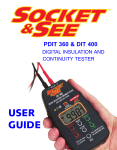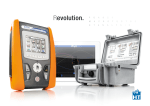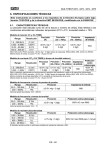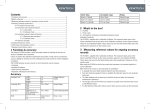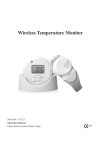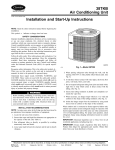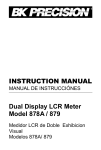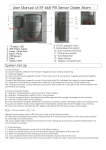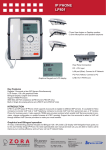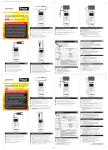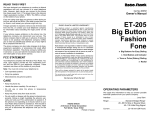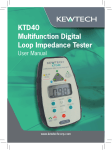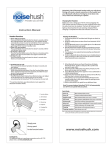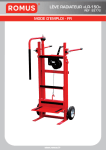Download Instruction Manual
Transcript
KTD30 Digital Insulation and Continuity Tester User Manual www.kewtechcorp.com 1 The Kewtech KTD30 Loop Impedence Tester is designed for use by suitably qualified personnel familiar with electrical supply systems. Operation – a Detailed View of the KTD30 Caution Before using your KTD30 please read these instructions; in particular note the safety issues that follow: 2 Your tester is for use on dead circuits only. Although your Kewtech instrument is fully protected against accidental connection to a live circuit it is essential to check the circuit is dead before working on it. 1 Live Circuit Your tester is equipped with a very convenient auto test (hands free) feature but do not touch the lead tips when using this feature. There may be capacitance on the circuit being tested (a longer than normal test time will indicate this condition). Your tester will automatically discharge this but do not disconnect the test leads until this auto discharge has completed. 2 LCD Display On the subject of test leads, always check for damaged leads or croc clips - Kewtech replacement lead sets are inexpensive and easy to obtain. 3 Power ON/OFF (including Intelligent Auto Power Off) The continuity circuit is fuse protected against accidental connection to mains (unlikely as there will be a warning to indicate a live circuit) - if this fuse does blow replace it with the correct type F 500mA fast blow ceramic 500V. It is located inside the battery compartment. BS EN 61010-1 6 Continuity Test Batteries Because of storage issues your tester is not supplied with batteries. ALWAYS REMOVE THE TEST LEADS BEFORE REPLACING BATTERIES. 7 Continuity Test Lead Null Just 4 AA cells are required (alkaline recommended). The battery compartment is at the the back of the instrument, remove the screw (do not lose it) – slide the battery cover off and carefully insert the batteries observing correct polarity. Replace cover and fix screw back in. 4 good quality AA alkaline cells should give 5000 tests at 500V DC. Note: Access to the protective fuse is also gained through the battery compartment. Always replace with the correct type – F 500mA Fast Blow Ceramic 500V. 4 Insulation Test 5 Insulation Test Voltage 250V 500V 1000V 8 Briefly Pust to Test (Instant) plus Push and Hold for 2 seconds for Auto Test (Hands Free) 3 1 2 LIVE CIRCUIT WARNING If this is alight – DO NOT PROCEED you are connected to a live circuit. This useful indicator will also show if a (capacitive) circuit under test is fully discharged before disconnecting any test leads. 1 LIVE CIRC UIT WARNING If this is alight – DO NOT PROCEED you are connected to a live circuit. This useful indicator will also show if a (capacitive) Display. When power up (Power ON/OFF) is selected your Kewtech circuit under test is fully discharged before disconnecting any test leads. The Push To Test Button performs two functions: A brief push (less than one second) initiates the test and automatically captures the result (which stays on screen until the next test, Power OFF or Mode change). For Auto Test the button is held down for longer than 2 seconds at which point is displayed in the LCD – you now have Hands Free – when the probes are touched onto any two test points your KTD30 will carry out an automatic test and capture the result for as long as the probes are held in contact. A brief push on the Test button unlocks Hands Free mode. LCD KTD30 will default to symbols CERT, INS, 500V this means it is ready to perform a 500V 2 LCD Display. When power up (Power ON/OFF) is selected your Socket & insulation Certification and it will thisthis test when briefly press Seetest PDITin360 will default tomode symbols CERT, INS,do 500V means it isyou ready button 8. to perform a 500V insulation test in Certification mode and it will do this test when you briefly hit button 9. CERT 4 8 INS 500V 5 Overview of the Display Overview of the Display I MΩ D H E CERT CONT INS 500V NUL 250V 1000V F C 3 Power ON/OFF – Pressing and releasing this button turns the PDIT 360 on holding down for longer than 2 seconds turns the unit off (plus Auto Power MΩ B is how display will will look youyou first first powerpower up the instrument. This This is how thethedisplay lookwhen when up the instrument. – 3 Power ON/OFF – Pressing and releasing this button turns the KTD30 on – Off is incorporated). holding down for selects longerInsulation than 2 seconds turns unit (plus to Auto Power Off is 4 This button Testing Mode (yourthe PDIT 360off defaults incorporated). Insulation Test 500V DC on Power On). 4 This button selects Insulation Testing (your KTD30 defaults circuits 500V DC (default) for circuitsMode up to and including 500V with the to Insulation Test 500V DC on Power exception of theOn). above systems A A Fuse BrokenDO DO NOT Fuse Broken NOTPROCEED PROCEED This allows selection of insulation test voltage 250V DC for SELV and PELV circuits 6 Selects Continuity Test Mode. 500V DC (default) for circuits up to and including 500V and 1000V for circuits abouve 500V B B Greater > GreaterThan Than // < < Less > LessThan Than C C Battery Condition Battery Condition D TestMode – CERT – Certification E Measuring Mode – INS – Insulation or CONT – Continuity F Insulation DC Volts Test Pressure – 250 – 500V DC 5 G 5 This allows selection of insulation test voltage 250V DC for SELV and PELV (SELV = Separated Extra-Low Voltage. PELV = Protective Extra-Low Voltage). (SELV = Separated Extra-Low Voltage. PELV = Protective Extra-Low Voltage). 6 Selects Continuity Test Mode. 7 Continuity Test Lead NULL – In order to give accurate continuity resistance results your tester will record the resistance of the test leads – store it and automatically subtract the stored value from any continuity measurement being made. To NULL the leads hold the test lead tips together very firmly with one hand and press the NULL Button – the result will be displayed – continuity testing will then subtract this stored value whenever Test Button 8 is pressed – the value is reset to zero after Power OFF (or Auto Power OFF) is selected. 4 A F good. = =good. = 1/2. Flashing = replace. = 1/2. Flashing = replace. D TestMode – CERT – Certification E Measuring Mode – INS – Insulation or CONT – Continuity Insulation DC Units Volts–Test 500-1000V DC G Measuring M –Voltage Insulation– –250– – Continuity G Measuring Units – MΩ – only) Insulation – stores Ω – Continuity H Nul Function – (Continuity Nuls and Ohms value of the test leads H Null Function – (Continuity only) Nulls and stores Ohms value of the test I AutoTest (Hands Free) Selected leads for the testing session you are in (automatically resets to zero on switch off) I AutoTest (Hands Free) Selected for the testing session you are in (automatically resets to zero on switch off) 6 Continuity Test Ranges Insulation Test Ranges Accuracy (Cert mode) 6 Accuracy (Cert mode) Ranges (Auto Range) Tolerance (@ 20°C) 0.00 to 9.99Ω ±3% ±2 digits 10.0 to 99.9Ω ±3% ±2 digits 100 to 999Ω Ranges (Auto Range) Tolerance (@200C) 0.01 to 9.99MΩ ±3% ±1 digit 10.0 to 99.9MΩ ±3% ±1 digit ±3% ±2 digits 100 to 199MΩ ±6% ±1 digit Open Circuit Voltage >4V, <10V 0.01 to 9.99MΩ ±3% ±1 digit Short Circuit Current >200mA 10.0 to 99.9MΩ ±3% ±1 digit Zero offset Adjust (Test Lead Null) 2Ω 100 to 199MΩ ±3% ±1 digit Typical Test Time (Cert mode) (2Ω) <2 sec 200 to 499MΩ ±6% ±1 digit 0.01 to 9.99MΩ ±3% ±1 digit 10.0 to 99.9MΩ ±3% ±1 digit 100 to 399MΩ ±3% ±1 digit 400 to 999MΩ ±6% ±1 digit Power 4 × AA alkaline batteries (not included) Battery Life (BS EN 61557) > 5000 tests @ 500V test voltage Environmental Test Voltage 250V 500V 1000V Output Voltage Operating Temperature Range 0°C to 40°C Storage Temperature Range –10°C to 60°C Voltage Load Output Current Tolerance Size 157mm × 89mm × 39mm 250 250kΩ 1 mA –0% +20% Weight 400g 500 500kΩ 1 mA –0% +20% 1000 1MΩ 1 mA –0% +20% Short circuit current (in to 2kΩ) <2mA Typical Test Time (cert mode) (10MΩ) <2 sec 7 8 Kewtech Corporation Limited Midas House, Unit 2b, Stones Courtyard, High Street, Chesham, Bucks HP5 1DE T: 01494 792 212 F: 01494 791 826 E: [email protected] www.kewtechcorp.com





